Ryang Heo
Can Large Language Models be Effective Online Opinion Miners?
May 21, 2025Abstract:The surge of user-generated online content presents a wealth of insights into customer preferences and market trends. However, the highly diverse, complex, and context-rich nature of such contents poses significant challenges to traditional opinion mining approaches. To address this, we introduce Online Opinion Mining Benchmark (OOMB), a novel dataset and evaluation protocol designed to assess the ability of large language models (LLMs) to mine opinions effectively from diverse and intricate online environments. OOMB provides extensive (entity, feature, opinion) tuple annotations and a comprehensive opinion-centric summary that highlights key opinion topics within each content, thereby enabling the evaluation of both the extractive and abstractive capabilities of models. Through our proposed benchmark, we conduct a comprehensive analysis of which aspects remain challenging and where LLMs exhibit adaptability, to explore whether they can effectively serve as opinion miners in realistic online scenarios. This study lays the foundation for LLM-based opinion mining and discusses directions for future research in this field.
Imagine All The Relevance: Scenario-Profiled Indexing with Knowledge Expansion for Dense Retrieval
Mar 29, 2025Abstract:Existing dense retrieval models struggle with reasoning-intensive retrieval task as they fail to capture implicit relevance that requires reasoning beyond surface-level semantic information. To address these challenges, we propose Scenario-Profiled Indexing with Knowledge Expansion (SPIKE), a dense retrieval framework that explicitly indexes implicit relevance by decomposing documents into scenario-based retrieval units. SPIKE organizes documents into scenario, which encapsulates the reasoning process necessary to uncover implicit relationships between hypothetical information needs and document content. SPIKE constructs a scenario-augmented dataset using a powerful teacher large language model (LLM), then distills these reasoning capabilities into a smaller, efficient scenario generator. During inference, SPIKE incorporates scenario-level relevance alongside document-level relevance, enabling reasoning-aware retrieval. Extensive experiments demonstrate that SPIKE consistently enhances retrieval performance across various query types and dense retrievers. It also enhances the retrieval experience for users through scenario and offers valuable contextual information for LLMs in retrieval-augmented generation (RAG).
Why These Documents? Explainable Generative Retrieval with Hierarchical Category Paths
Nov 08, 2024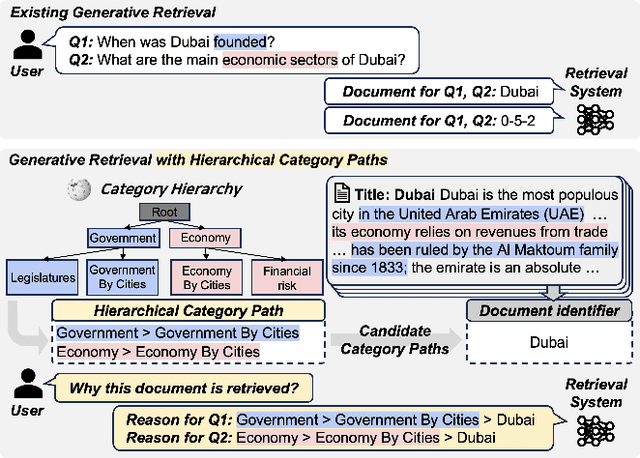
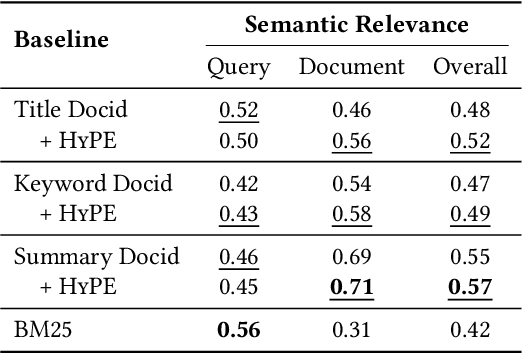
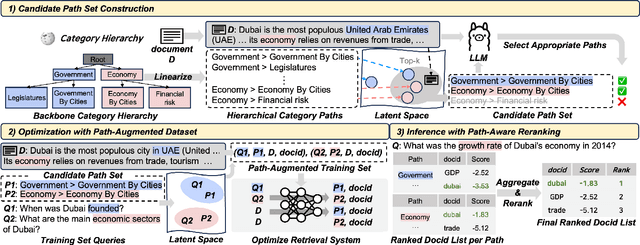
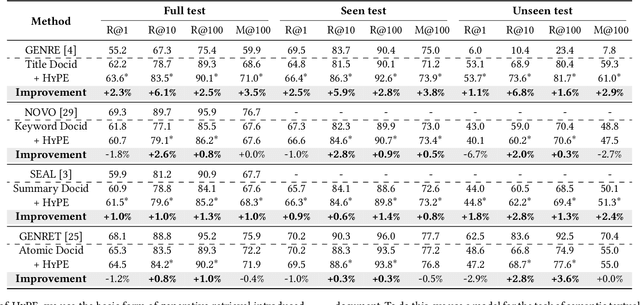
Abstract:Generative retrieval has recently emerged as a new alternative of traditional information retrieval approaches. However, existing generative retrieval methods directly decode docid when a query is given, making it impossible to provide users with explanations as an answer for "Why this document is retrieved?". To address this limitation, we propose Hierarchical Category Path-Enhanced Generative Retrieval(HyPE), which enhances explainability by generating hierarchical category paths step-by-step before decoding docid. HyPE leverages hierarchical category paths as explanation, progressing from broad to specific semantic categories. This approach enables diverse explanations for the same document depending on the query by using shared category paths between the query and the document, and provides reasonable explanation by reflecting the document's semantic structure through a coarse-to-fine manner. HyPE constructs category paths with external high-quality semantic hierarchy, leverages LLM to select appropriate candidate paths for each document, and optimizes the generative retrieval model with path-augmented dataset. During inference, HyPE utilizes path-aware reranking strategy to aggregate diverse topic information, allowing the most relevant documents to be prioritized in the final ranked list of docids. Our extensive experiments demonstrate that HyPE not only offers a high level of explainability but also improves the retrieval performance in the document retrieval task.
Make Compound Sentences Simple to Analyze: Learning to Split Sentences for Aspect-based Sentiment Analysis
Oct 03, 2024Abstract:In the domain of Aspect-Based Sentiment Analysis (ABSA), generative methods have shown promising results and achieved substantial advancements. However, despite these advancements, the tasks of extracting sentiment quadruplets, which capture the nuanced sentiment expressions within a sentence, remain significant challenges. In particular, compound sentences can potentially contain multiple quadruplets, making the extraction task increasingly difficult as sentence complexity grows. To address this issue, we are focusing on simplifying sentence structures to facilitate the easier recognition of these elements and crafting a model that integrates seamlessly with various ABSA tasks. In this paper, we propose Aspect Term Oriented Sentence Splitter (ATOSS), which simplifies compound sentence into simpler and clearer forms, thereby clarifying their structure and intent. As a plug-and-play module, this approach retains the parameters of the ABSA model while making it easier to identify essential intent within input sentences. Extensive experimental results show that utilizing ATOSS outperforms existing methods in both ASQP and ACOS tasks, which are the primary tasks for extracting sentiment quadruplets.
Self-Consistent Reasoning-based Aspect-Sentiment Quad Prediction with Extract-Then-Assign Strategy
Mar 01, 2024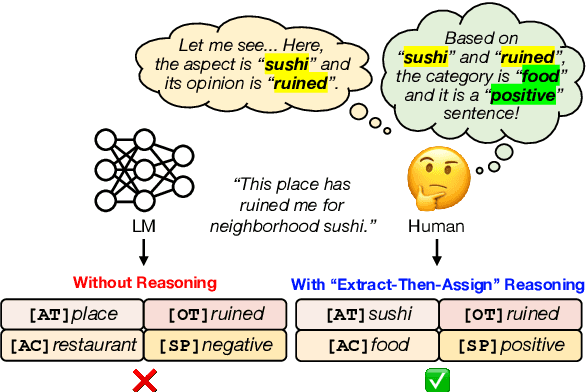
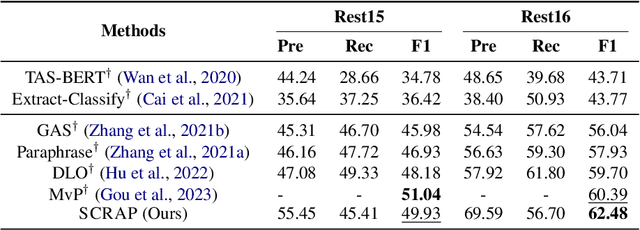
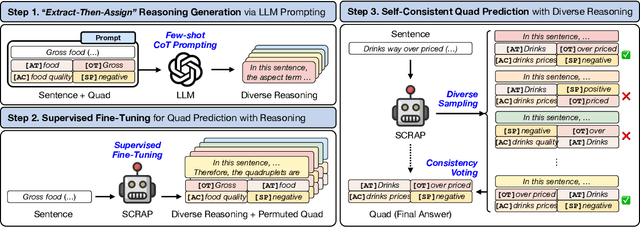
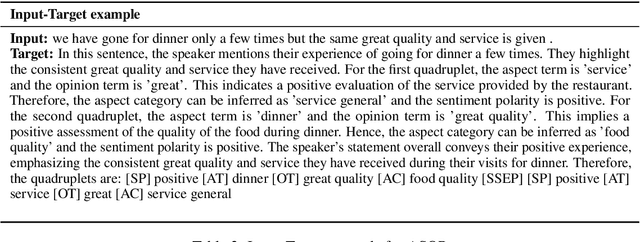
Abstract:In the task of aspect sentiment quad prediction (ASQP), generative methods for predicting sentiment quads have shown promising results. However, they still suffer from imprecise predictions and limited interpretability, caused by data scarcity and inadequate modeling of the quadruplet composition process. In this paper, we propose Self-Consistent Reasoning-based Aspect-sentiment quadruple Prediction (SCRAP), optimizing its model to generate reasonings and the corresponding sentiment quadruplets in sequence. SCRAP adopts the Extract-Then-Assign reasoning strategy, which closely mimics human cognition. In the end, SCRAP significantly improves the model's ability to handle complex reasoning tasks and correctly predict quadruplets through consistency voting, resulting in enhanced interpretability and accuracy in ASQP.
 Add to Chrome
Add to Chrome Add to Firefox
Add to Firefox Add to Edge
Add to Edge